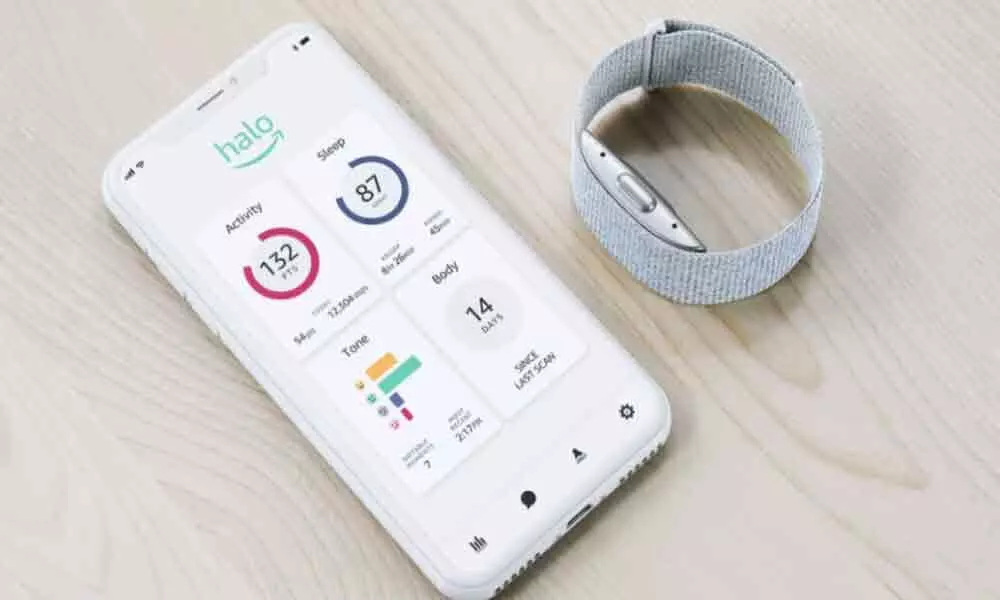Live
- GMR Airports Unveils AI-Powered Digital Twin Platform to Transform Airport Operations
- India poised to become leading maritime player: PM Modi
- Top Causes of Kidney Stones and How to Recognize Silent Symptoms
- India’s renewable energy capacity logs 14.2 pc growth at 213.7 GW
- Winter Session of Odisha Assembly adjourned sine die
- Biden calls Trump's tariff approach 'major mistake'
- After Drama Over Eknath Shinde’s Chief Minister Race, Maharashtra Cabinet Formation Faces New Tensions
- Egyptian FM, Blinken discuss recent developments in Syria
- Iran's supreme leader says Syria's developments result of US-Israeli 'plot'
- Elon Musk to Purchase $100 Million Luxury Mansion Next to Donald Trump's Mar-a-Lago, Report Reveals
Just In
Amazon Halo Band can scan your body and voice


Amazon Halo band
Amazon tells the Halo Band "is not a medical device" and didn't submit the device to the FDA for any approval.
Amazon is all set to enter the health device market with a new fitness band and subscription service called Halo. Unlike the Apple Watch or even the most basic Fitbits, the Amazon Halo Band has no display. The accompanying app comes with the usual set of fitness tracking features along with two groundbreaking and potentially worrying ideas: use your camera to create 3D body fat scans, and hear the emotion in your voice.
Halo Band will be priced at $ 99.99, and the service (which is needed for more advanced Halo features) costs $ 3.99 per month. Amazon is launching it today as an invitation-only early access program with an introductory price of $ 64.99 that includes six months of free service. The Halo service is not part of Amazon Prime, it a separate product.
The screen missing on the Halo Band is the first indicator that Amazon is still trying to make a place for itself by focusing a little less on sports and exercise and a little more on lifestyle changes. In addition to cardio, sleep, body fat, and tone of voice tracking, a Halo subscription will offer a suite of partner-developed "labs." They are short challenges designed to improve your health habits, such as meditation, improving your sleep habits, or starting basic exercise routines.
Amazon tells the Halo Band "is not a medical device." As such, the device has not been submitted to the FDA for any kind of approval, including the "FDA clearance" of the lighter touch that many other fitness bands have used.
Body Scans
Body scans work only with your smartphone camera. The app instructs you to wear tight clothing (ideally just your underwear) and then move about two meters away from your camera. Then you take four photos (front, back, and both sides) and upload them to Amazon's servers, where they are combined into a 3D scan of your body that is sent back to your phone. The data is then removed from Amazon's servers.
Halo need four photos of your body for scans
Once you have the 3D scan, Amazon make use of machine learning to analyze and calculate the body fat percentage. Amazon says that body fat percentage is a reliable indicator than weight or body mass index. Amazon also claims that smart scales that attempt to measure body fat using bioelectrical impedance are not as accurate as their scan.
Once you have your scan, the app will give you a little slider that you can drag your finger over to show what it would look like with more or less body fat.
Tracking your voice tone
The Amazon Halo Band microphone is not designed for voice commands; instead, listen to her voice and report on what she thinks her emotional state was during the day. If you don't sign up, the Band's mic doesn't do anything at all.
Once you sign up, the Halo app will ask you to read a text to it so you can train an ideal on your voice, allowing the Halo Band to be the only clue in your tone and not those around you. After that, the Band will hear your voice intermittently and judge it based on metrics like positivity and energy.
It's a passive, intermittent system, which means you can't actively ask it to read your tone and it's not listening to all the time. You can also mute the microphone at any time by pressing the button until a flashing red LED appears briefly to show you that it is muted.
Amazon takes care that your voice is never uploaded to any server and is never heard by any humans. The Halo Band sends its audio snippets to your phone through Bluetooth, and it is analyzed there. Amazon says the Halo app immediately removes voice samples after analyzing them to determine your emotional state.
It collects the pitch, intensity, rhythm, and tempo of your voice and then classify them into "notable moments", which you can go back and analyse all over the day. Few of the emotional states include words like hopeful, euphoric, hesitant, bored, regretful, happy, worried, confused, and affectionate.

© 2024 Hyderabad Media House Limited/The Hans India. All rights reserved. Powered by hocalwire.com






